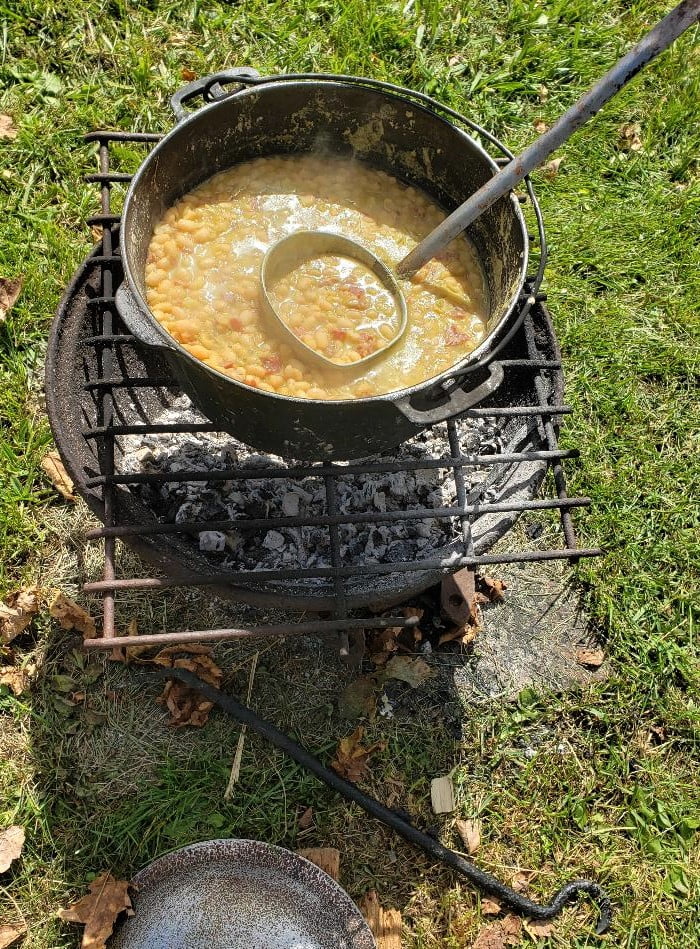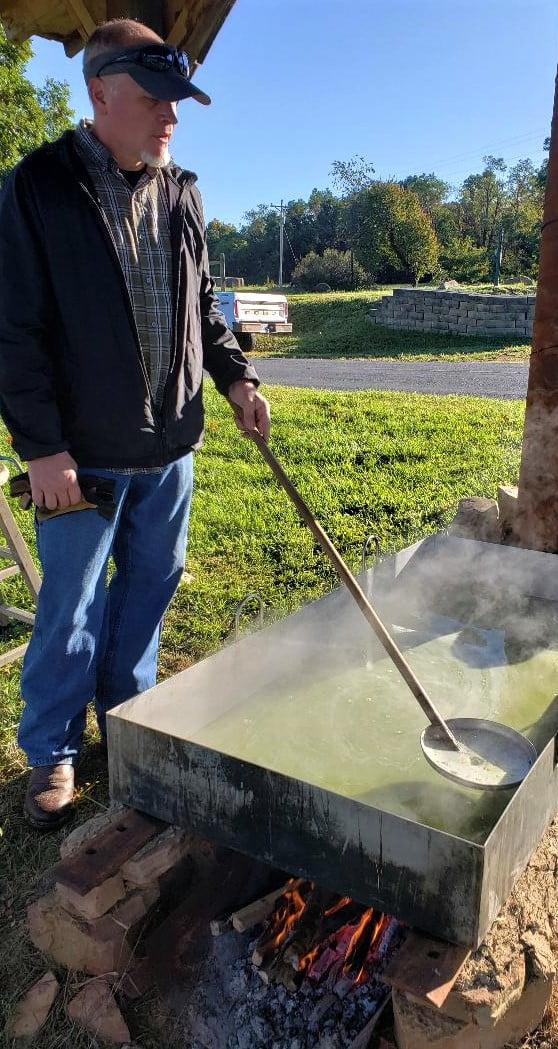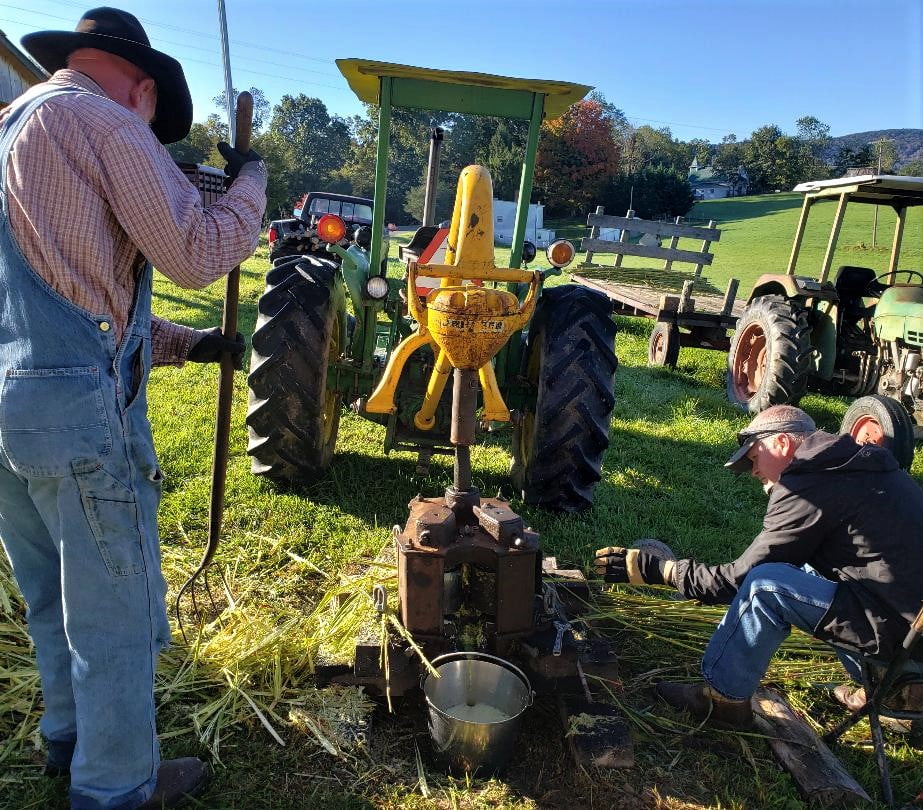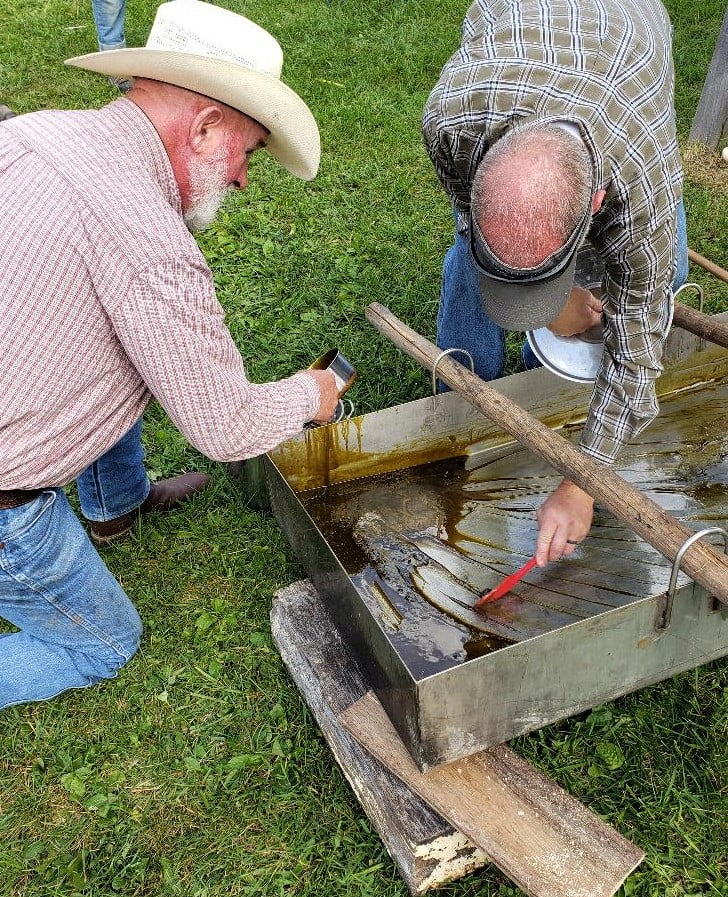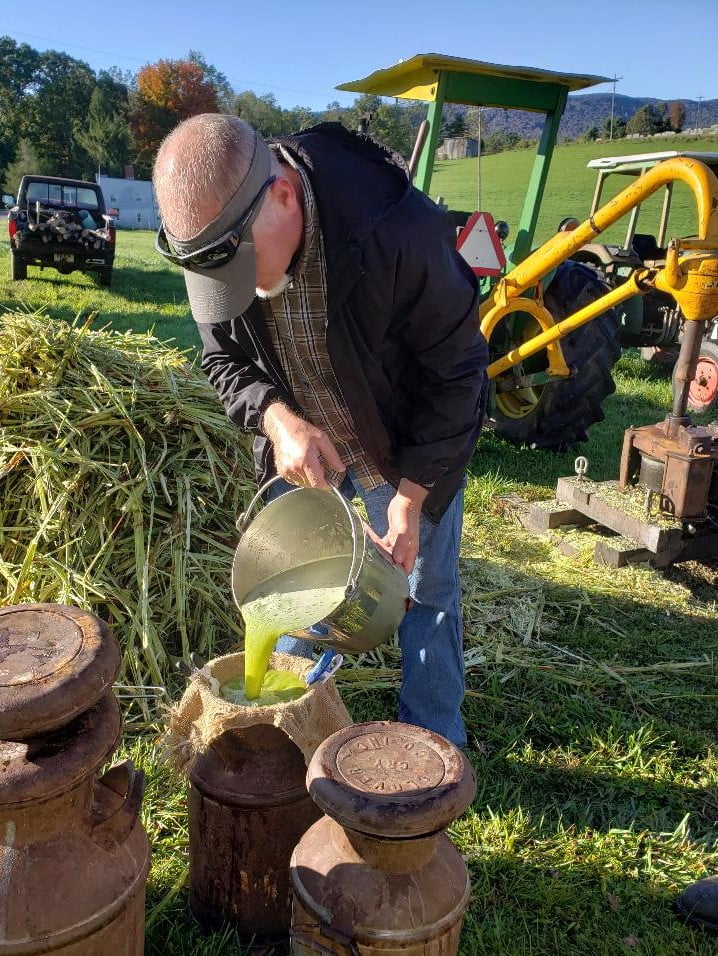The thoughts of homemade biscuits, pulled chicken BBQ, fresh cooked country ham on the woodstove and navy beans cooking in a cast iron skillet that had been sprinkled with country ham and a hint of molasses, made the task of molasses making, enjoyable.

It was Rodney Hutton’s 15th year of making molasses across from the Looney Schoolhouse, on Saturday, October 3, and everyone seemed to have a great time.
Rodney and his twin sons, Joey and Jody all were working diligently to prep the area for the making of molasses. They ran some of the cane through the mill the night before to get a head start on the day.
Rodney and his sons shared that this year was the smallest crop yield they had ever had in their 15 years of making molasses.
They usually harvested a few wagons loaded about a foot tall. This year they only had one wagon and it was a small load.
They exclaimed, “We had an early frost, and it was just the year 2020.”
The weather was perfect for the family event, as in year’s past they have had blistering cold winds.
They explained that, “In the field as it grows, you walk it and strip the leaves and stuff off and then cut it by hand and lay it across the wagon.”
They clip the seed head off the tops to use as seed for next year. He did two different spots this year but neither yielded much cane.
They put the stalks through the mill press which squeezes the juice out into a bucked on the side and pushes the stalks out at the end. The cane was skinnier this year, as sometimes they are the size of a man’s thumb.
The mill press can be adjusted to fit the stalk size. The one they used was made in 1896 (another they have was made in 1895).
“It’s cast iron and it is heavy,” Rodney Hutton shared. “I put this one together for it to work today.”
Rodney and one of his twin sons, Joey, shared their stories. The other twin son, Jody, was busy cutting wood and starting the fire.
Rodney moved to Craig in 1957. This is his 15th year in making molasses, as his family has been doing on the first Saturday of October.
However, Rodney remembered making molasses with a mule instead of the tractor hooked up to the press. “A pole was attached to the press back then and a mule walked around in a circle to run the press.”
Rodney added, “We go back in history here. The store is from 1900 and the school was deeded in 1893. Before the school, they had a log cabin which they called “Frog Pond Academy”. Before they cut Route 42 there use to be a pond. When they blasted the road, it sunk. At one time there was four stores close by because every holler in the mountain that had water, as family lived on both sides of the mountain, had stores. Also, the old Homeplace house is over 250 years old. It was a grant from King Ann to Looney. History is here.”
Joey had a little stool he sat beside the mill press as he slowly fed the stalks through it.
He noted that they try to get all of the leaves off because they would carry the juice through the mill instead of allowing it to be poured into the bucket catching the juice.
He added that when they had the larger stalks, he would be soaked from the juice from his thighs down.
“There would be so much juice, they would squirt out as I run them through the mill,” he shared. “One time my pants leg froze up to where I couldn’t even straighten it as the sugar had dried.”
After it is pressed, Joey skimmed the juice with a strainer to rid it of any stalk that had dropped in it. Then they put a burlap sack over a large tin canister and poured it through to catch any remainder stalk.”
Also, they would whittle a little of the outside off the stalk and hand it out to people to chew on and enjoy the lightly sweet flavor of cane.
During the early morning, the Hutton’s pressed the rest of the cane and continued with the steps before pouring the liquid in the large rectangular pan they had placed over a level fire pit to start the cooking process.
“On average, we only get a nine or ten to one ration of molasses from the liquid we start with. If we put ten gallons on, we only get about one gallon off. Every season varies, as the sugar content within the stalks vary each year.”
They continued, “On average, we only get a nine or ten to one ration of molasses from the liquid we start with. If we put ten gallons on, we only get about one gallon off. Every season varies, as the sugar content within the stalks vary each year.”
When there is a bigger crop, there are about ten people manning each process. “This year, we thought with all the rain it would have been better, but it just did not do,” Rodney explained.
Rodney added, “As it cooks, we skim any impurities off the top.” Rodney had the pan they used, made several years ago. It holds 45 gallons.
“You want the fire to be hot enough to keep it at a small rolling boil,” Joey shared as he stirred.
Occasionally, they take the “skimmings” off with their stirrer pan, as they continuously stir the liquid to keep it from scorching.
Often, it takes until later in the evening to finish, but this year, they pulled the liquid off a little after noon time.
“One year we were 2 o’clock in the morning pulling it off,” Rodney exclaimed. “Every year varies.”
Joey noted, “This is our first year ever of not having a full pan.”
Still, the molasses was done, and it was time to “break bread” as Joey shared and run your biscuit through the sides of the pan to get out the remainder of the molasses.
“That’s probably one of the favorite parts of the day,” he added. “Even if you have to use your finger.”
He added that there have been times they threw steaks in the pan with the remainder of the molasses. “Now that’s some good eating!”
Rodney enjoys the older fashioned hand tools that are made to last. “Some are made like a gunsmith would make something, with brass insets…it’s perfect and lasts forever!” as he proved with the 1896 mill running at full speed.
He also enjoys his woodworking. He built a beautiful table with benches edged with the bark of the trees, along with other special things he ‘tinkers’ with.
He remembered his dad “saucer and blowing” his coffee in a ironstone saucer, saying after he would “surp his coffee”, “Willie, this would scald a hog” and sometimes adding, “That was strong enough it would float an iron wedge!”
He added that his mom would take red corn cobs and brown sugar and made them some syrup.
“People were innovative back then, as you did with what you had,” Rodney said. “We always had pork in the meat house, potatoes from the garden and mom’s cornmeal and lard crock.”
He shared she would dip her three fingers in the lard to make “the best biscuits ever in her wood stove”. She could make a huge pan of biscuits, talking to you the whole time and never make a move from what she was doing.
Rodney put his navy beans on early. He added his salty ham and slow cooked them in the cast iron pot for a few hours, until near the end he added the molasses for a final touch. “You can’t cook them like that in the house!” Joey exclaimed with a waiting anticipation. “They’ll flap your taste buds out!”
Later, they pulled out the apple press to make some fresh apple cider.
It was time for the family meal as everyone enjoyed their pulled chicken BBQ sandwich, baked beans, cole slaw and molasses covered navy beans. They also got to taste the local trout that was baked on the low burning fire, which was also sprinkled with a little molasses. “That’s the best fish I’ve ever tasted!” one shouted out. “I want a little more of that!”
“It’s been a super fun annual event that we enjoy,” Joey shared.
Rodney added, “It’s a good time where all the family can get together and people can learn about their history.”



